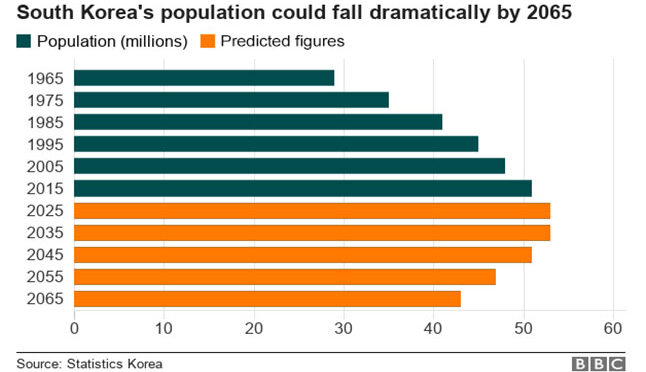A HARBINGER OF DEMOGRAPHIC TRANSITION: DECLINING POPULATION TRENDS OF SOUTH KOREA
Posted on : February 22, 2023Author : Shrestha Ghosh

ABSTRACT
This article focuses on the looming crisis in South Korea in regards to underpopulation. The declining trends in population are expected to bring forth a massive demographic transition in the country that would have a fundamental impact on world demographics as well. South Korean youth population which consists of the majority of the work force there, is estimated to reach its minimum in recent years. If not controlled for this would have adverse effects on the country’s economy that would be cohesively difficult to undo. This article therefore talks about the reasons behind the declining trends, low fertility rates being one of them, the impacts of the same and certain policy prospects that might help the country improve the situation and prevent an enormous crisis.
Key Words: Underpopulation; Demographic transition; Low fertility rates
INTRODUCTION
The world is expecting a massive demographic shift in the upcoming future. Underpopulation although quite frequently talked about often gets overshadowed by the persistent problem of overpopulation in some of the largest developing economies of the world. South Korea however is bracing for a momentous demographic shift that could be a bellwether of how other countries around the world will deal with aging populations in the decades to come (Lee & Botto, 2021) In context of the same, this article aims to discuss the role of the declining population of South Korea as a harbinger of demographic transition alongside the reasons pertaining to the same.
The fourth largest economy of the world, South Korea is believed to have been locked in an invisible battle for its future decades against its declining population. As of reports released in 2021 by the Statistics Korea, the country is losing this battle. With this looming crisis, a lot of questions arise regarding its competency in global economic and technological grounds. The country’s ability to maintain deterrence and defense postures along with the stability of their socioeconomic inequalities might be jeopardized.
As dire as the situation already sounds, the government institution in charge of statistics and census data mapped out a worst-case scenario, according to which the present population will drop to around 12 million by 2120 — around 23% of today’s population (Tokyo,2021). The country’s total population of 52 million was set to decline by 0.18% by the end of 2021 financial year, as it did. World population review as of February,2023 also confirms that the previously mentioned decline has continued because the estimated population currently stands at 51.7 million, roughly. Korea stands at the 29th position on the population rank, with a growth rate of 0.04%. This comprises of 0.65% of the world population which is very trivial if examined. The UN estimates this population to stabilize by July,2023 followed by a subsequent fall in the upcoming years.South Korea’s population growth rate has slowed significantly, decreasing from 0.1% to 0.09% from 2019 to 2020. Having stated the projections, we would now discuss some of the possible reasons for this declining trend in population.
POSSIBLE REASONS BEHIND THE DECLINING TRENDS IN POPULATION
Triggered by the country’s extensive economic development in the 1960s and 1970s, post the Korean war (1950-53), South Korea experienced a rapid demographic transition. By the 1990s, this country had risen to be one of most advanced nations of Asia, enriched with prosperity. However, over the same period several influential family planning programs were responsible for a sharp decline in the Korean birth rates, which was followed by a steady fall in population over several subsequent years.
- Low fertility rates
South Korea’s total fertility rate has been below the replacement rate of 2.1 births per woman since 1983 (The Diplomat,2022). As the UN world population prospect suggests, this low fertility rate is detrimental in deepening the downward trend in Korean demographics. Korean family planning programs have fundamentally caused a decline in birth rates from 6.1 children per women in 1960 to 1.6 by 1990. This country became the first to experience a total fertility rate below 1 in 2018. Ever since, it has declined every year before reaching 0.81 in 2021. According to world population projections, South Korean women have the lowest fertility rate in the world at present which stands at 0.92. This implies that women there are expected to have less than one child, which is pretty uncanny. Women in South Korea are reluctant to give birth for several reasons.
- Acute pressure on families
This has been prevalent as a structural issue for several years, but as of today it stands as ‘education passion’ in parents who desperately want their children to succeed. Several opportunities have been created in the country as an aftermath of the explosive economic growth and development that succeeded the Korean war. Many of such opportunities were beyond the realms of imagination of the present generation of grandparents in the country. Parents consider ‘elite education’ as crucial for fostering job opportunities and well-being amongst their children. In fact, most South Korean families dedicate nearly 50% of their annual income for the same purpose making it practically impossible for them to have more than one child. Hence, it is a structural weakness in Korea’s corporate world and society in general. The younger generation today finds it particularly difficult to negotiate job security, even if they do it is more likely to happen in their mid 50s which is often considered the phase to propagate and join the self-employed work force.
- Insecurity amongst the younger generation
The inability to find a secure and well-paid job often forces young men to join the part-time positions which offer little security. This in particular fosters a uncertainty which does not stand conducive to future planning, which includes starting a family. Often some women are observed to be waiting a little longer than usual to procreate as they are more driven towards building their careers and pursuing higher education. Fertility rate as discussed earlier decreases with increase in age. Figures released by the Seoul Metropolitan Government on December 16 show that the number of marriages in the city has fallen by 43% in the last 20 years, down from 78,745 in 2000 to 44,746 last year. The average age of first marriages was 33 in 2020, up from 29 two decades ago (Tokyo,2021). Together with the low fertility rates a default of increased aging, contributes significantly to low population trends.
IMPACT OF DECLINING TRENDS IN POPULATION: DEMOGRAPHIC TRANSITION
Lee and Botto in their article published in the year 2021 suggests that by 2050 every one in six people would be over the age of 65 as against one in eleven as recorded in the year 2019. This massive polarization of the population would be a worldwide phenomenon however South Korea is ahead of the curve. South Korea had a gigantic population of the non-working age group of less than 14 years, as recent as 2005. However, the last few decades witnessed an enormous fall in the youth demographics. This country now has the smallest youth population, only higher than Japan’s. It was expected to surpass Japan in having the smallest youth population in 2022. As South Korean population statistics suggests, it is experiencing an increase in population of senior citizens aged 65 and above. The figures have grown from 10.8% in 2010 to 17.5% in 2022. Based on these current statistics, senior citizens would account for 30% of the total population in Korea by the year 2030 and 40% by 2051.
The aforementioned is destined to greatly affect the perspectives of the South Korean economy. The aging of the population will result in continuous decline in the working age population aged 15-64. Between now and 2050, Statistics Korea expects the working age population will decline from 37.38 million in 2020 to 24.19 million in 2050. The U.N. medium variant estimate is more pessimistic, expecting a working age population of only 20.96 million. The low variant estimate is only slightly lower.Workers between ages of 25-49, those who are in their prime working years, however, are expected to decline from 36.8 percent of the population to 23.1 percent by 2050. (Stangarone,2022).
The impact of a decline in working age population would be extensive on the country’s growth and development. The pandemic, according to the IMF, seems to have worsened the situation already. The sustained decline in population will continuously weigh down economic growth. Female labour force participation rates are also expected to fall. The trends are expected to burden the pension system in the country as well alongside a decrease in military capacity due to fewer young males for South Korea’s conscription-based military.
POLICY PROSPECTS
It is crucial for South Korea to look into its demographic statistics and undertake measures to reduce the negative impacts due to its shift. It needs certain economic, social and cultural transformations to sustain economic development, maintain social welfare, alleviate socioeconomic inequalities and promote a high standard to living. A new social compact and a comprehensive reevaluation of how South Korea aims to preserve its global competitiveness are also necessary in response to the country’s impending population catastrophe. Increased immigration needs to be considered by South Korea as a possible remedy to avoid catastrophic demographic changes. On a corporate level, to increase the workforce, the country might consider changing their retirement age from 60 to perhaps 65 as in India or 67 as in Italy. They might also want to coerce firms to re-hire retirees who are still able and fit the job requirements per se.
REFERENCES
- Lee, C.M. and Botto, K. (2021) Demographics and the future of South Korea, Carnegie Endowment for International Peace. Available at: https://carnegieendowment.org/2021/06/29/demographics-and-future-of-south-korea-pub-84817 (Accessed: February 11, 2023).
- Ryall, J. (2021) What’s behind South Korea’s population decline? – DW – 12/21/2021, dw.com. Deutsche Welle. Available at: https://www.dw.com/en/whats-behind-south-koreas-population-decline/a-60210895 (Accessed: February 11, 2023).
- Stangarone, T. (2022) South Korea’s demographic trends continue to decline, – The Diplomat. for The Diplomat. Available at: https://thediplomat.com/2022/08/south-koreas-demographic-trends-continue-to-decline/ (Accessed: February 11, 2023).
- World Population Review (no date) South Korea population 2023 (live). Available at: https://worldpopulationreview.com/countries/south-korea-population (Accessed: February 11, 2023).
By Shrestha Ghosh.
Intern at Asia In Global Affairs.





Leave a Reply